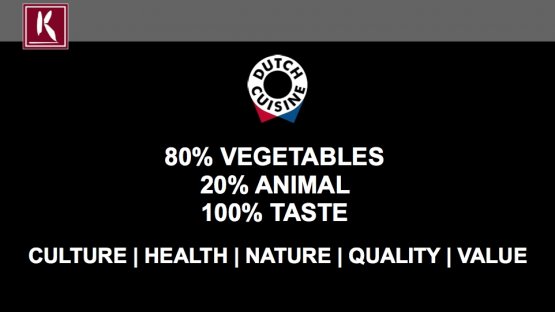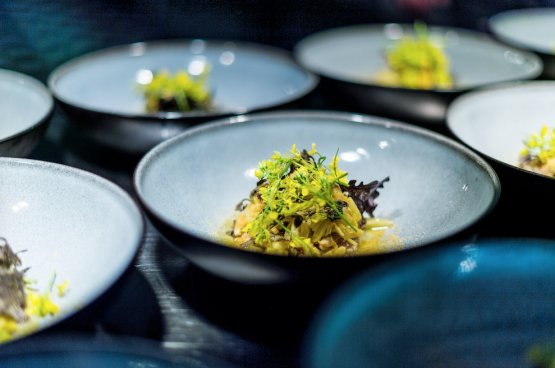Is Rotterdam the nerve centre of contemporary gastronomy? Of course not. Yet The Netherlands’ largest town, and the largest port in Europe, is a sort of food lab, today’s projection of what food might be like in our future. It shows clear trends, which not everyone might like, but are certainly significant: urban vegetable gardens, organic farming, recovery of small productions, healthy food. Rotterdam is a sort of neutral field: there are no sound culinary traditions, plus it’s a multi-ethnic town. It’s clean, tidy, civilised, very pleasant to visit, organised, modern: even in terms of architecture it’s a sort of experimental model, a neutral and vaguely aseptic place where – far away from strong roots, family recipes, overflowing classics, yet very close to a concept of balanced progress – one can not only discuss but also put into practice these possible models for food development that combine environmental sustainability, healthy food and correct diet.
Put it this way, it would look like a gourmand paradise. Perhaps this is not really the case. For instance, there are no not-to-be-missed restaurants, no absolute points of reference for fine dining. Yet it offers an exceptional reference point for how our daily diet can be made better, and even more sustainable. Indeed local rural farms and labs work in unison perhaps not necessarily to reach the highest excellence – Italians at least don’t need to travel so far to find it... – but a correct everyday diet. Rotterdam has many stories worth telling: floating cultivated fields, experimental fermentations, food waste recovery techniques… Here are some excerpts from the future.
Enrico Zallot is from Feltre, born in 1954. Plainspoken, he moved to Rotterdam a while ago. He’s the country manager at
Koppert Cress, a micro-greens giant exporting all around the world and supplying around 60 thousand restaurants. A green kingdom made of sprouts, seedling, leaves, flowers, each with its special organoleptic effect. They make our dishes tastier, as well as healthy and ecological. «Our future’s worst enemy is the kind of farmer
Carlin Petrini likes» he starts straightforwardly. Excuse me? «Of course. Traditional agriculture will never be sustainable. The image of a farmer lovingly growing tomatoes and selling them to consumers is foolish, and
Slow Food knows it. Let’s be clear: they’re doing their part, it’s right that they fight to preserve some principles. Yet this is the future of agriculture» and he points at a sort of landscape that looks like it’s out of a sci-fi film.
The greenhouse goes as far as the eyes can see. It’s technological, lit by thousands of small led lights; it’s eight metres tall, so as to allow a production of 5 different layers of sprouts. An inner circuit makes it possible in the summer for the water warmed up by the atmosphere inside the greenhouse and by the lights’ cooling system to be stored in a huge tank underground and later used for the winter heating; a second tank (a total of 100K cube metres!) allows for the opposite mechanism, favouring an ecological air-conditioning 365 days a year.
But let’s return to the “bad” famer. «We must feed 7.4 billion people in the world – says Zallot – Those who say you can do so with your uncle’s vegetable garden are kidding you. Agriculture must produce large numbers, hence it has to be intensive. Yet to be so, if it stays outdoors and thus exposed to bad weather, insects, parasites and bacteria, it requires massive quantities of chemicals.
Outdoor agriculture is in other words terribly polluting». The indoor one, instead, yields 10 times more, they say at Koppert Cress. And it is “naturally protected”: «We spend 70 thousand euros in beneficial insects, which help us fight parasites. We insert them in the greenhouse – they would scatter outdoors – and we can thus perfectly protect our sprouts». Zallot: «Ladybugs work 365 days a year and have no unions. They are worth 26 cents each for us».

The Dutch Cuisine manifesto
The city of Rotterdam, with its suburbs, reaches one million inhabitants, of which 150 thousand are obese and 500 thousand are overweight. This is where the
Dutch Cuisine movement was born. It aims at spreading a new food culture, 80% based on vegetables. Many of the most important Dutch chefs have joined them. It is also convenient for them: the
Variatie in de Keuken foundation calculated the effects on the profit, when a restaurant uses more vegetarian dishes. The result was that the profit margin increases by 23%.
Rob Baan, patron at Koppert Cress, is one of the Dutch Cuisine ambassadors: «We eat too much meat. In Rotterdam we should eat a total of 250 thousand kilos of vegetables every day. Instead, we eat 220 thousand kilos of meat, worth 700 cows, and waste 35% of the food resources. In order to have 250 thousand kilos of vegetables, we’d need 2 thousand hectares. To have the equivalent in meat, we need 85 thousand. We were the first overpopulated country in the world, we don’t even have space for urban farms, but we have plenty of water. This is the perfect place to teach everyone a new type of diet».

Indeed Rotterdam is Europe’s agricultural delta: there’s no other place where the industry is as important and rich. Visit the city markets and you’ll see some 40 different types of tomatoes. They come from the greenhouses and are exported everywhere. They don’t seem particularly tasty, yet they are healthy and sustainable. Besides, with the aid of other aromatic vegetables, one of the most famous chefs in town,
Jim de Jong, uses them to make a delicious (yet fake: it’s all made of vegetables)
steak tartare. He’s 28, with previous experience at
Le Jardin des Sens in Montpellier and later with
Gordon Ramsay, and at his restaurant
De Jong he offers a mostly vegetal –
ça va sans dire – market-based cuisine with a set menu: 4 vegetarian dishes, or 2 plus a meat or fish dish, for 45 euros. A great experience.
(1, to be continued)